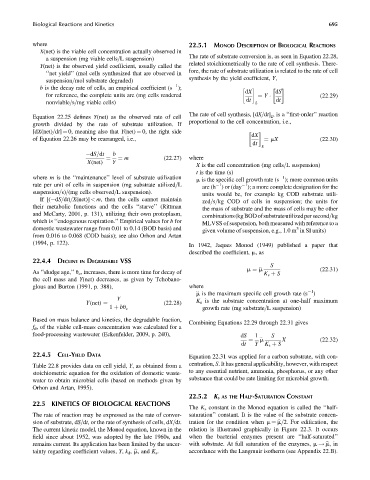Page 740 - Fundamentals of Water Treatment Unit Processes : Physical, Chemical, and Biological
P. 740
Biological Reactions and Kinetics 695
where 22.5.1 MONOD DESCRIPTION OF BIOLOGICAL REACTIONS
X(net) is the viable cell concentration actually observed in
The rate of substrate conversion is, as seen in Equation 22.28,
a suspension (mg viable cells=L suspension)
related stoichiometrically to the rate of cell synthesis. There-
Y(net) is the observed yield coefficient, usually called the
fore, the rate of substrate utilization is related to the rate of cell
‘‘net yield’’ (mol cells synthesized that are observed in
synthesis by the yield coefficient, Y,
suspension=mol substrate degraded)
1
b is the decay rate of cells, an empirical coefficient (s );
dX dS
for reference, the complete units are (mg cells rendered ¼ Y (22:29)
dt dt
nonviable=s=mg viable cells) g
The rate of cell synthesis, [dX=dt] g ,isa ‘‘first-order’’ reaction
Equation 22.25 defines Y(net) as the observed rate of cell
proportional to the cell concentration, i.e.,
growth divided by the rate of substrate utilization. If
[dX(net)=dt] ¼ 0, meaning also that Y(net) ¼ 0, the right side
dX
of Equation 22.26 may be rearranged, i.e., ¼ mX (22:30)
dt g
dS=dt b
¼ m (22:27) where
¼
X(net) Y
X is the cell concentration (mg cells=L suspension)
t is the time (s)
where m is the ‘‘maintenance’’ level of substrate utilization m is the specific cell growth rate (s ); more common units
1
rate per unit of cells in suspension (mg substrate utilized=L are (h ) or (day ); a more complete designation for the
1
1
suspension=s)=(mg cells observed=L suspension). units would be, for example kg COD substrate utili-
If [( dS=dt)=X(net)] < m, then the cells cannot maintain zed=s=kg COD of cells in suspension; the units for
their metabolic functions and the cells ‘‘starve’’ (Rittman the mass of substrate and the mass of cells may be other
and McCarty, 2001, p. 131), utilizing their own protoplasm, combinations(kgBODofsubstrateutilizedpersecond=kg
which is ‘‘endogenous respiration.’’ Empirical values for b for
MLVSS of suspension, both measured with reference to a
domestic wastewater range from 0.01 to 0.14 (BOD basis) and 3
given volume of suspension, e.g., 1.0 m in SI units)
from 0.016 to 0.068 (COD basis); see also Orhon and Artan
(1994, p. 122).
In 1942, Jaques Monod (1949) published a paper that
described the coefficient, m,as
22.4.4 DECLINE IN DEGRADABLE VSS
S
_
m ¼ m (22:31)
As ‘‘sludge age,’’ u c , increases, there is more time for decay of K s þ S
the cell mass and Y(net) decreases, as given by Tchobano-
glous and Burton (1991, p. 388), where
_ 1
m is the maximum specific cell growth rate (s )
Y K s is the substrate concentration at one-half maximum
(22:28)
Y(net) ¼
1 þ bu c growth rate (mg substrate=L suspension)
Based on mass balance and kinetics, the degradable fraction,
Combining Equations 22.29 through 22.31 gives
f d , of the viable cell-mass concentration was calculated for a
food-processing wastewater (Eckenfelder, 2009, p. 240), dS 1 _ S
m X (22:32)
dt Y K s þ S
¼
22.4.5 CELL-YIELD DATA Equation 22.31 was applied for a carbon substrate, with con-
Table 22.8 provides data on cell yield, Y, as obtained from a centration, S. It has general applicability, however, with respect
stoichiometric equation for the oxidation of domestic waste- to any essential nutrient, ammonia, phosphorus, or any other
water to obtain microbial cells (based on methods given by substance that could be rate limiting for microbial growth.
Orhon and Artan, 1995).
22.5.2 K S AS THE HALF-SATURATION CONSTANT
22.5 KINETICS OF BIOLOGICAL REACTIONS
The K s constant in the Monod equation is called the ‘‘half-
The rate of reaction may be expressed as the rate of conver- saturation’’ constant. It is the value of the substrate concen-
sion of substrate, dS=dt, or the rate of synthesis of cells, dX=dt. tration for the condition when m ¼ bm=2. For edification, the
The current kinetic model, the Monod equation, known in the relation is illustrated graphically in Figure 22.3. It occurs
field since about 1952, was adopted by the late 1960s, and when the bacterial enzymes present are ‘‘half-saturated’’
remains current. Its application has been limited by the uncer- with substrate. At full saturation of the enzymes, m ! bm,in
tainty regarding coefficient values, Y, k d , bm, and K s . accordance with the Langmuir isotherm (see Appendix 22.B).

